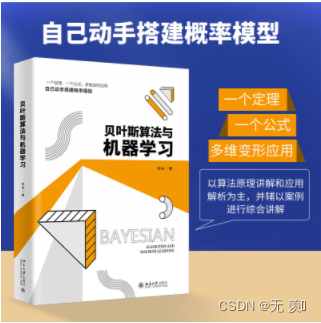
文章目录
一、布尔索引二、between()三、isin()1. 单列筛选2. 多列筛选3. 通过字典的形式传递多个条件4. 删除异常值所在行5. isnotin实现 四、loc、iloc(重要)0. 创建DataFrame1. 提取行数据2. 提取列数据3. 提取多列数据4. 提取指定行、指定列数据5. 提取所有数据6. 提取指定数据行 ?参与抽粉丝送书啦
在数据分析清洗数据过程中,可能需要会滤掉、删除DataFrame中一些行,本文将介绍常用的筛选方法。
一、布尔索引
布尔索引可以用于判断和筛选
>>> import pandas as pd>>> import numpy as np>>>>>> df = pd.DataFrame(np.random.randn(3, 3), columns=['A', 'B', 'C'])>>> print(df) A B C0 -0.595510 -1.349175 -0.3139181 1.130604 -2.094348 -0.4491822 1.745407 -0.136642 -0.943479>>>>>> # 布尔索引判断:A列大于1的数>>> print(df['A'] > 1)0 False1 True2 TrueName: A, dtype: bool>>>>>> # 布尔索引筛选:A列中大于1的行>>> print(df[df['A'] > 1]) A B C1 1.130604 -2.094348 -0.4491822 1.745407 -0.136642 -0.943479二、between()
between(left,right),筛选指定区间的行
>>> import pandas as pd>>>>>> data = {'name': ['小红', '小明', '小白', '小黑'], 'age': [10, 20, 30, 25]}>>> df = pd.DataFrame(data)>>> print(df) name age0 小红 101 小明 202 小白 303 小黑 25>>>>>> # 判断年龄是否在20-30之间>>> print(df['age'].between(20, 30))0 False1 True2 True3 TrueName: age, dtype: bool>>> # 筛选年龄在20-30之间的行>>> print(df[df['age'].between(20, 30)]) name age1 小明 202 小白 303 小黑 25三、isin()
isin()接收一个列表,可以同时判断数据是否与多个值相等,若与其中的某个值相等则返回True,否则则为False
创建DataFrame:
>>> import pandas as pd>>> import numpy as np>>>>>> data = [['foo', 'one', 'small', 1], ['foo', 'one', 'large', 5],... ['bar', 'one', 'small', 10], ['bar', 'two', 'samll', 10],... ['bar', 'two', 'large', 50]]>>> df = pd.DataFrame(data, columns=['A', 'B', 'C', 'D'])>>> print(df) A B C D0 foo one small 11 foo one large 52 bar one small 103 bar two samll 104 bar two large 501. 单列筛选
df[df[列名].isin([异常值])]
>>> # 1. 接收一个值:判断A列中的值是否为foo>>> df['A'].isin(['foo'])0 True1 True2 False3 False4 FalseName: A, dtype: bool>>>>>> # 2. 接收多个值:判断A列中的值是否为foo,bar>>> df['A'].isin(['foo','bar'])0 True1 True2 True3 True4 TrueName: A, dtype: bool2. 多列筛选
同时满足用&连接,或的话用 | 连接
筛选出每列都有异常值的行:df[df[列名].isin([异常值])& df[列名].isin([异常值])]
>>> # 筛选中A列中等于bar,并且B列中等于one的行>>> df[df['A'].isin(['bar'])& df['B'].isin(['one'])] A B C D2 bar one small 10筛选出至少有一列有异常值的行:df[df[列名].isin([异常值])| df[列名].isin([异常值])]
>>> # 筛选中A列中等于bar,或者B列中等于one的行>>> df[df['A'].isin(['bar']) | df['B'].isin(['one'])] A B C D0 foo one small 11 foo one large 52 bar one small 103 bar two samll 104 bar two large 503. 通过字典的形式传递多个条件
{‘某列’:[条件],‘某列’:[条件],}
# 这种方法不符合的位置都会显示NAN>>> df[df.isin({'A':['bar'],'C':['small']})] A B C D0 NaN NaN small NaN1 NaN NaN NaN NaN2 bar NaN small NaN3 bar NaN NaN NaN4 bar NaN NaN NaN4. 删除异常值所在行
因为isin()返还的是boolean的DataFrame,在里面的是True,不在里面的是False,所以我们只需要对它进行异或取反即可。
# 删除A列中foo的行>>> df[True^df['A'].isin(['foo'])] A B C D2 bar one small 103 bar two samll 104 bar two large 505. isnotin实现
前面加上 ~
# 删除A列中foo的行>>> df[~(df['A']=='foo')] A B C D2 bar one small 103 bar two samll 104 bar two large 50四、loc、iloc(重要)
loc()函数和iloc()函数的区别在于:
loc()函数是通过索引名称提取数据iloc()函数通过行和列的下标提取数据0. 创建DataFrame
>>> import pandas as pd>>>>>> data = [['foo', 'one', 'small', 1], ['foo', 'one', 'large', 5],... ['bar', 'one', 'small', 10], ['bar', 'two', 'samll', 10],... ['bar', 'two', 'large', 50]]>>> df = pd.DataFrame(data, columns=['A', 'B', 'C', 'D'], index=['a', 'b', 'c', 'd', 'e'])>>> print(df) A B C Da foo one small 1b foo one large 5c bar one small 10d bar two samll 10e bar two large 501. 提取行数据
>>> # loc取索引为a的行(第一行)>>> df.loc['a']A fooB oneC smallD 1Name: a, dtype: object>>>>>> # iloc取索引为a的行(第一行)>>> df.iloc[0]A fooB oneC smallD 1Name: a, dtype: object2. 提取列数据
>>> # loc取A列所有行>>> df.loc[:, ['A']] Aa foob fooc bard bare bar>>>>>> # iloc取A列所有行>>> df.iloc[:,[0]] Aa foob fooc bard bare bar3. 提取多列数据
(1)连续多列:
>>> # loc取A,B,C列所有行>>> df.loc[:, ['A', 'B', 'C']] A B Ca foo one smallb foo one largec bar one smalld bar two samlle bar two large>>>>>> # iloc取A,B,C列所有行>>> df.iloc[:, 0:3] A B Ca foo one smallb foo one largec bar one smalld bar two samlle bar two large(2)不连续多列
>>> # loc取A,D列所有行>>> df.loc[:, ['A', 'D']] A Da foo 1b foo 5c bar 10d bar 10e bar 50>>>>>> # iloc取A,D列所有行>>> df.iloc[:, [0,3]] A Da foo 1b foo 5c bar 10d bar 10e bar 504. 提取指定行、指定列数据
>>> # loc取索引为a、d,并且列名也为A、D的行和列>>> df.loc[['a', 'd'], ['A', 'D']] A Da foo 1d bar 10>>>>>> # iloc取索引为a、d,并且列名也为A、D的行和列>>> df.iloc[[0, 3], [0, 3]] A Da foo 1d bar 105. 提取所有数据
>>> # loc取全部>>> df.loc[:,:] A B C Da foo one small 1b foo one large 5c bar one small 10d bar two samll 10e bar two large 50>>>>>> # iloc取全部>>> df.iloc[:,:] A B C Da foo one small 1b foo one large 5c bar one small 10d bar two samll 10e bar two large 506. 提取指定数据行
利用loc可以对值进行筛选
>>> # loc取A列值为foo的行>>> df.loc[df['A'] == 'foo'] A B C Da foo one small 1b foo one large 5>>>>>> # loc取D值大于等于10的行>>> df.loc[df['D'] >= 10] A B C Dc bar one small 10d bar two samll 10e bar two large 50?参与抽粉丝送书啦
书籍展示:《 贝叶斯算法与机器学习 》
【书籍内容简介】
涵盖了贝叶斯概率、概率估计、贝叶斯分类、随机场、参数估计、机器学习、深度学习、贝叶斯网络、动态贝叶斯网络、贝叶斯深度学习等。本书涉及的应用领域包含机器学习、图像处理、语音识别、语义分析等。本书整体由易到难,逐步深入,内容以算法原理讲解和应用解析为主,每节内容辅以案例进行综合讲解。也有不想靠抽,想自己买的同学可以参考下面的链接:
当当自营购买链接:http://product.dangdang.com/29478966.html